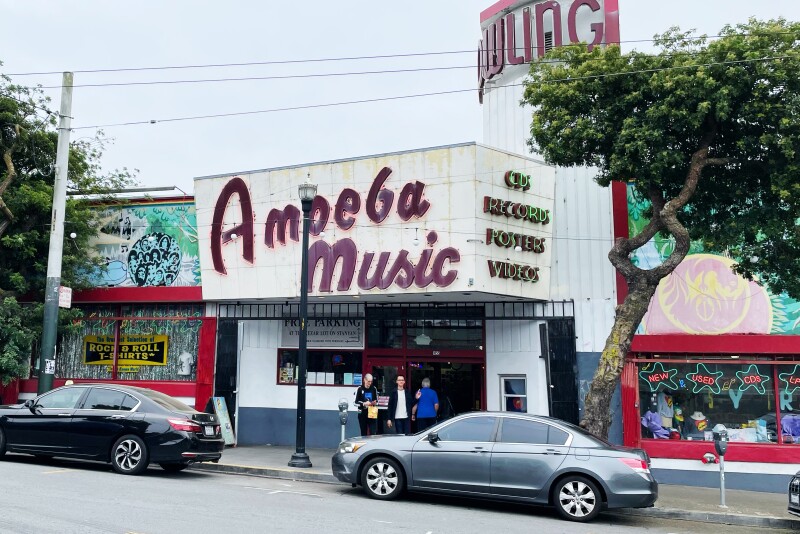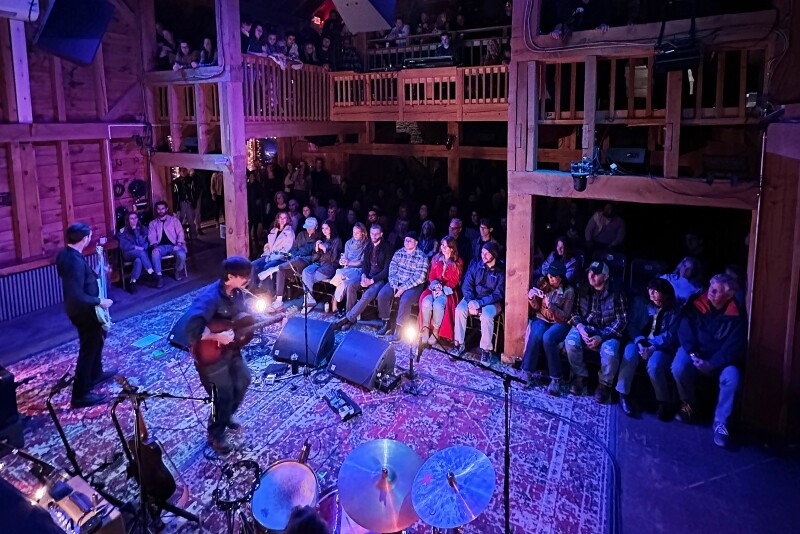There may be no better way to experience the soundtrack of America than on a leisurely, music-themed road trip, with the windows (or convertible top) down and the hits blasting. And while cities like Nashville, New York, and New Orleans will always be celebrated for their music heritage, you’ll need to head for small towns to truly immerse yourself in the juke joints and honky-tonks, the farms and rural recording studios, where icons honed their craft and invented new forms of expression. Load up a playlist and get ready to hit the road.
Feel the blues in the Mississippi Delta
- Start: Tunica, Mississippi
- End: Vicksburg, Mississippi
- Distance: About 180 miles
- Recommended time: Two to three days
Memphis may be a major blues hub, but true aficionados know that you have to make a pilgrimage to the genre’s birthplace in the Mississippi Delta. Highway 61 weaves through the flat, fertile fields and historic farming communities that birthed legends like Muddy Waters and B.B. King—and that have earned the Delta the nickname “the Most Southern Place on Earth.”
Get your bearings at the Gateway to the Blues Museum, housed inside the town of Tunica’s 1890s train depot, near the boyhood home of Robert Johnson, and then continue along to Clarksdale, where he reportedly sold his soul to the devil at the Crossroads. (While the exact location has always been up for debate, there’s a popular Crossroads Monument at the intersection of Highways 61 and 49.) After wandering through the Delta Blues Museum, immerse yourself in the sounds of the South at the Morgan Freeman–owned Ground Zero Blues Club or the cash-only juke joint Red’s Lounge, before checking in at the Travelers Hotel. The hotel originally opened in the 1920s as a bathroom-down-the-hall stopover point for railroad workers, but it’s been reimagined as a shabby-chic boutique hotel decorated with quilts and artwork from Mississippi artists.
As you continue driving south, each town reveals a new chapter in the story of the blues. Rural Cleveland is home to the Grammy Museum Mississippi (the state is home to more Grammy winners per capita than anywhere else in the USA) and Dockery Farms, a cotton gin where blues pioneers like Howlin’ Wolf and Willie Brown worked as they wrote songs. Pick up some hot tamales (a local Delta specialty) at Airport Grocery and make a detour to the gravesite of Robert Johnson in Greenwood and the birthplace of B.B. King in Berclair, 15 miles away, before checking out a museum in King’s honor in nearby Indianola. Back on Highway 61, Leland is home to its own scrappy Highway 61 Blues Museum, a worthy stopping point before finishing up in Vicksburg. The riverside birthplace of Willie Dixon is now a buzzing city of riverboat casinos and restaurants like 10 South Rooftop Bar & Grill, which offers sweeping views of the Mississippi River and the Yazoo Canal.

Ameoba Music is an essential pitstop for any music fan.
Photo by marleyPug/Shutterstock
Embrace the Summer of Love on California Highway 1
- Start: San Francisco, California
- End: Big Sur, California
- Distance: About 150 miles
- Recommended time: Two to three days
Channel your inner hippie with a ’60s-themed road trip that kicks off in San Francisco. A morning stroll through Golden Gate Park will put you in the mindset of the Human Be-In, which unofficially kicked off the Summer of Love in 1967, but the best place to embrace the spirit is the still-groovy Haight-Ashbury, where the psychedelic sounds of Janis Joplin, Jefferson Airplane, and the Grateful Dead used to ring out. (Be sure to pick up a few of their albums at the cavernous Amoeba Music, which is stocked with hundreds of thousands of albums and feels like a cathedral dedicated to the religion of popular music.) After dark, see who’s headlining at the Fillmore, a century-old venue where the Dead played 51 concerts in the late ’60s.
The next day, wake up early at the boho Hotel Zeppelin and begin your drive south along Highway 1, stopping at the Grateful Dead Archive at UC Santa Cruz before continuing along to Monterey, the site of the Monterey International Pop Festival, which set the template for Woodstock. Visit shops like Recycled Records, which opened in 1975, and Siren Records Monterey, which only stocks new vinyl, CDs, and cassettes.
Farther down the coast in Big Sur, stop at the Henry Miller Memorial Library, which honors the frequently banned author of Tropic of Cancer; the cultural center hosts occasional musical gigs and has welcomed the likes of David Crosby and the Red Hot Chili Peppers. And then finish by getting mindful at Esalen, a retreat center where you can take wellness workshops and follow in the footsteps of George Harrison, Mama Cass Elliot, Joni Mitchell, and Joan Baez, all of whom sought enlightenment on these wild cliffs.

The Levon Helm Studios in Woodstock, NY, was built by the drummer of The Band.
Photo by Michelle Heimerman
Honor folk pioneers in New York
- Start: New York City
- End: West Saugerties, New York
- Distance: About 175 miles
- Recommended time: Two or three days
Begin your celebration of the 1960s folk scene in Bob Dylan’s Greenwich Village. After recreating the album cover of The Freewheelin’ Bob Dylan with a photo on the corner of Jones Street and West Fourth Street, catch a set at his old stomping grounds, such as the Bitter End, where Joan Baez and Joni Mitchell used to perform, or Café Wha?, where Dylan played on his first night in the city in January 1961 after hitchhiking across the country from Minnesota. Crash at the recently revamped Hotel Chelsea, which opened in the 1880s and has counted the likes of Patti Smith and Leonard Cohen among its regulars. Now home to a swanky lobby bar and revived Spanish restaurant El Quijote, the hotel has shaken off the seedier side of its reputation (it’s the site, for instance, where Sid Vicious allegedly killed his partner Nancy Spungen).
The next morning, chart a course upstate toward Bethel Woods Center for the Arts, a performing arts center and museum on the site of the 1969 Woodstock Music & Art Fair, which includes the land that used to be Max Yasgur’s dairy farm. New this year, you can camp on site, including a glamping option with in-tent bathrooms. If not, cut back east through the Catskills toward the town of Woodstock. Try to time your visit to a performance at the warmly collegial Levon Helm Studios, an acoustically engineered barn built by the legendary drummer of the Band, where his family is keeping the legacy of his famed Midnight Rambles alive. And there’s only one natural place to stay the night: Big Pink, an unassuming house in nearby West Saugerties where Dylan and the Band recorded The Basement Tapes.

Sun Studio in Memphis was the site of the famous Million Dollar recording session that brought together Elvis Presley, Jerry Lee Lewis, Carl Perkins, and Johnny Cash.
Photo by f11photo/Shutterstock
Embark on a greatest hits drive through Tennessee
- Start: Memphis, Tennessee
- End: Bristol, Tennessee
- Distance: About 500 miles
- Recommended time: Five to seven days
Although it’s the 36th largest state by area and the 15th by population, Tennessee has always punched way above its weight class musically. This eastbound itinerary starts in Memphis, where you can choose your own adventure: Honor rock history with tours of Sun Studio and Graceland, listen to the blues on Beale Street, or feel the spirit at the Stax Museum of American Soul. Drive about 60 miles east to Brownsville’s West Tennessee Delta Heritage Center, which is housed in the one-room schoolhouse Anna Mae Bullock (later Tina Turner) attended as a child and is now filled with her memorabilia—the only Tina Turner museum in the world.
Begin the countrified portion of your trip by paying your respects at the spot in Camden (85 miles farther east) where Patsy Cline died in a 1963 plane crash, and then drive another 40 minutes and drop into Loretta Lynn’s Ranch in Hurricane Mills for a guided tour. When you finally get to Nashville, you could stay for a day or a week or a month and still not see all the greatest hits: Country Music Hall of Fame and Museum, National Museum of African American Music, Ryman Auditorium, the Bluebird Café. . . . On the northeastern outskirts of town, take a backstage tour at the Grand Ole Opry and overnight at the adjacent Gaylord Opryland Resort & Convention Center.
As you make your way into the Appalachian half of the state, you can finish up in downhome style in Pigeon Forge at Dollywood, which welcomes a new Dolly Parton Experience this spring, highlighting her work as a songwriter, style icon, and philanthropist. If you don’t stop and stick around a while at her new HeartSong Lodge & Resort, you can continue along to the place where it all started: Bristol, Tennessee, along the Virginia border, is home to the Smithsonian-affiliated Birthplace of Country Music Museum. It tells the story of the 1927 recording sessions that are considered the “big bang” of the country music genre.

The Rock & Roll Hall of Fame, designed by I. M. Pei, is dedicated to the most famous and influential figures in music.
Photo by BorisVetshev/Shutterstock
Go on a three-city tour across the Midwest
- Start: Cleveland, Ohio
- End: Chicago, Illinois
- Distance: About 450 miles
- Recommended time: At least four days
The shores of the Great Lakes and the Rust Belt cities that surround them have been the site of some major musical innovation. Begin your tour of the Midwest in Cleveland, the home of the Rock & Roll Hall of Fame, which has a new exhibit honoring 2023 inductees like Missy Elliott, Willie Nelson, Chaka Khan, and Rage Against the Machine. If you’ve ever wondered how the city earned the honor of hosting the I.M. Pei–designed museum, it’s because of DJ Alan Freed, who promoted the new genre and broke down racial barriers in music in the 1950s. Honor his legacy with a visit to his jukebox-shaped grave in Lake View Cemetery.
Drive westward along I-90, cutting north at Toledo toward Detroit, where the Motown Museum is set to undergo a multi-million-dollar renovation and expansion. The museum incorporates Hitsville U.S.A., the record label’s first headquarters, in a white house on West Grand Boulevard that founder Berry Gordy bought in 1959. Enjoy a meal at the Black-owned Waffle Cafe at 18685 Livernois Avenue and see the Motown mural on its exterior wall by artist Fel’le, featuring the likenesses of Smokey Robinson, the Temptations, the Supremes, and more.
Continue westward through Michigan, and blow into the Windy City. Chicago is associated with so many forms of music, including blues, gospel, and modern jazz, but Gen X-ers and elder Millennials will love it for its contribution to the indie rock scene of the past three decades—it is the home to both Lollapalooza and Pitchfork Music Festival, after all. Snap an obligatory shot of the corn-cob-shaped Marina City towers, which graced the cover of Wilco’s Yankee Hotel Foxtrot; stop for a pint at the Rainbo Club, a dive where Liz Phair took her iconic Exile in Guyville album cover shot in the photo booth; and then see who’s playing at the Empty Bottle, Lincoln Hall, Riviera Theatre, or the Metro. Or for something a little more classic, end your night at the Green Mill Cocktail Lounge, a bebop and free jazz club that’s been going so long that Al Capone used to be a regular. While not Chicago’s most luxurious stay, Hotel Versey, is steeped in rock history; it used to be nicknamed the Rock and Roll Days Inn and has welcomed Greg Allman, Nirvana, Radiohead, and more. Kurt Cobain and Courtney Love dyed their hair in the bathtubs here, and Sheryl Crow rollerbladed through the lobby. (Don’t do that, it’s not allowed.)











